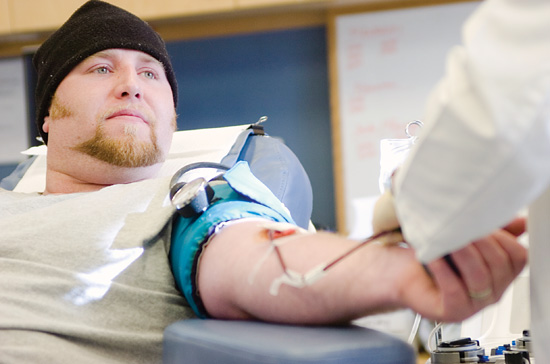|
|
|
 |
|
| Eureka resident Chris Armstrong comes to the blood bank every four weeks to donate plasma and has his blood drawn by his wife Tiffany, who first convinced Chris to give blood. Tyson Ritter/The Eureka Reporter |
| |
|
| 'Tis the season to give ... blood |
| by Ashley Bailey, The Eureka Reporter, 12/10/2007 |
| |
Although the Northern California Community Blood Bank reports that
yellow, red and green are the most popular blood donation bandage
colors at local high schools, Chris Armstrong, of Eureka, settled for a
black one when he donated blood at the NCCBB on Monday.
Armstrong said he has been donating a pint of plasma every four weeks for four years now, totaling more than 5 gallons.
“It helps save lives; it keeps people healthy – it’s being a Good Samaritan, I guess,” he said.
As Armstrong began to give blood, John Gullam, director of the blood bank’s donor resources, recalled why he became a donor.
He
said that when his daughter was 20 months old, she had open heart
surgery and it made him think twice about how valuable donating blood
can be.
“It makes you think,” he said. “A lot of people assume that if they go to the hospital, there will be blood for them.”
Donors
usually come in on Thursdays or Fridays, Gullam said, to sit in the
blue chair and have a small needle poked in their arm to save lives.
In return, blood donors receive a colored bandage of choice, and refreshments such as coffee and apple pie.
As the holidays approach, Gullam said, it is especially important that people donate blood.
“Donors get so busy with the holidays; we really need folks to come in,” he said.
Dozens
of photos lined the walls of the blood bank’s Eureka location,
including one of Leroy Murrel, who has donated more than 60 gallons of
blood in his lifetime.
All the blood collected from Humboldt
County residents such as Murrel is taken to a laboratory where it is
separated and analyzed by type.
Mike Walkner, a medical technologist for the blood bank, demonstrated how to test for a blood type.
With
blue gloved hands, he poured different solutions in several test tubes,
added a donor’s blood to all of them and put them in a centrifuge.
Within
minutes, Walkner removed the test tubes, each labeled for a different
blood type, and looked for clumping. The donor’s blood type is the same
as that labeled on the tube that contains clumps.
Gullam said that all blood types are needed, but O negative is always the most requested because it is universal.
“We
want people to come in because they want to help,” he said. “It’s not
another unit when somebody walks in the door – it’s a person.”
As Armstrong finished donating blood platelets, he was bandaged and welcomed to the snack area.
He helped himself to a croissant, but was disappointed in the pie selection.
He said he doesn’t really care for apple. |
|
|
|